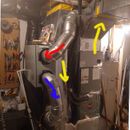HRV Ducts Tied to Furnace System
Hello
First off, thanks to everyone for all the very interesting conversations and discussions. This is my first post, but I’ve been following this site for years, very informative.
I have moved into a 2500 square foot house in climate zone 5, with a central air furnace. The house was built in 2005, and the HRV was installed at that time.
It’s a GreenTek, and ties into the furnace system, as there are no fans inside the HRV. The control is a simple humidistat.
I have scanned multiple sites and discussion forums to confirm if this installation is effective, but I’ve never seen anyone suggest this.
I’ve attached a picture. The yellow arrows show the furnace flow: the return is on the left; it goes down to the bottom to the furnace blower and the supply is on the right.
The HRV fresh air supply comes in at the return (blue) and the exhaust is further downstream (red) in the supply plenum.
To me, this makes absolutely no sense. Isn’t a sizable portion of the fresh air simply getting exhausted out with this setup? I can’t see how this works.
I feel like the fix here is to put them all on the return duct, with the exhaust port of the HRV first, upstream from the fresh air intake, and ensure that they are at least 3 feet apart. Also, make sure that the fresh air intake is at least 10 feet from the furnace blower.
Is this just a classic case of the installer not having a clue how to set up an HRV back in 2005?
Thanks for your feedback. Mark.
GBA Detail Library
A collection of one thousand construction details organized by climate and house part










Replies
Air handler flow rates are much much higher than ventillation flow rates. A percentage of the fresh air from the HRV will be exhaust but only after mixing with the return air from the house so not enough to matter.
The bigger issue with this type of setup is they are pretty challenging to balance and keep in balance. Since they rely on the pressure drop on the return and the supply trunks to push flow through the HRV, if any of these change (ie slowly clogging air filter) it will put the HRV out of balance. Also the unit can only ever be truly balanced at one furnace air flow setpoint, if it is running on low or fan only, it will also unbalance the unit. Most HRV manufacturers no longer offer this type of unit for this reason.
Overall it is still much better than exhaust only ventilation. Picking up a budget differential manometer, checking the air flow across the HRV core and re-balancing the unit can help a fair bit with efficiency.
Thanks for the reply. I will look into getting a differential manometer and seeing what the numbers look like. My furnace doesn't have variable speeds either so it's all or nothing, and I doubt there is balance.
Do you think putting both hrv intakes and exhaust on the return ducts would be a better option? I guess I could use the manometer to measure pressure differentials in the two points on the return ducts that I am planning to put them and see if it's more balanced there.
I might scrap this altogether and set up dedicated ducting for a new ERV, I have access to several points to run ducts to and from.
Balance in this case refers to the airflow matched across the HRV core, that is both supply and exhaust airflows are about the same. The pressure from the air handler just drives this flow, the air handler pressure itself doesn't need to be balanced for it to work.
As currently plumbed is the only way this unit will work as it needs a negative pressure for the fresh air supply and a positive pressure for exhaust. If you move it all to the supply side, it won't work.
To balance the unit, you'll have to find the install manual for the unit. This will give you differential pressure across the HRV core and correlating flow numbers, this is what you want to measure and adjust. The HRV will have 4 pressure ports on it, one for each air stream. You connect the pressure gauge to these ports to figure out the air flow and adjust the dampers on the HRV accordingly. For example see P18 here:
https://www.gasexperts.ca/wp-content/uploads/2016/05/vanEE-70E-Installation-Guide.pdf
If you do replace the unit, make sure to get one with ECM blowers, these use much less power and since it will be running 24/7, this bit of power saved can add up to some real money.
That makes sense. I realized that without fans, this HRV needs the air handler to move the air, and this is the only way it could work. I am fairly certain that it's far from effective, I've insulated the house quite well, and the CO2 levels are hovering around 1000, so I'm hoping to lower them a bit. I might ride this system out for a few years and perhaps look into a new, more efficient system then. I think the air blower draws 800 watts so it's a bit of an energy hog.
Thanks for the info!
I've used a Honeywell ERV tied into the furnace/ac ducts and interlocked with the air handler, which is variable speed, for many years. It works wonderfully. I have it set to ASHRAE standards for the size of the house and it turns itself on and off as needed throughout the day. It takes very little energy to run and the low speed of the air handler takes very little as well.